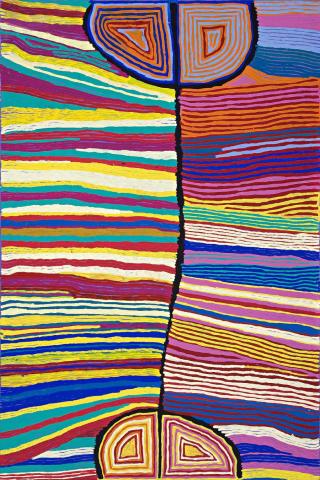KURRKARA JUKURRPA AT MINA MINA, 2007
JUDY NAPANGARDI WATSON
synthetic polymer paint on linen
183.0 x 122.0 cm
inscribed verso: artist's name, size and Warlukurlangu Artists catalogue number 788/07
Warlukurlangu Artists, Yuendumu
Gallery Gondwana, Sydney
Private collection, Melbourne
Ryan J., Colour Power, Aboriginal Art Post 1984, in the collection of the National Gallery of Victoria, National Gallery of Victoria, Australia, 2004, cover, p. 33 and p. 124
Born at Yarungkanji, Mt Doreen Station, Judy Napangardi Watson had a traditional life growing up in her ancestral country at Mina Mina andYingipurlangu, situated on the border of the Tanami and Gibson Deserts.Despite flanking these major deserts, the country is particularly fertile, producing a bounty of bush tucker whose vibrant forms and hues form the foundation for Watson's use of colour.
Watson was taught to paint by her elder sister Maggie Napangardi Watson. They would often paint alongside each other at Warlukurlangu Artists, with both sisters developing their own unique styles. Since then, Watson's work has received considerable acclaim, culminating in her inclusion in the 2006 exhibition Opening Doors at the Aboriginal Art Museum in The Netherlands, an exhibition which then toured to the Sprengel Museum in Hanover, Germany.
This painting is accompanied by a certificate of authenticity from Warlukurlangu Artists Aboriginal Association, Yuendumu, and tells the story associated with the ceremonial site of Mina Mina. This site belongs to the Japanangka/Japangardi men and the Napanangka/Napangardi women. The story describes how mythological women depicted in this painting sat down under the shade of a Kurrkara tree (Desert Oak).
On their travels north from Kantakarlangu to Janyinki the women collected many types of bush tucker including Jintiparnta (edible fungus), Ngalyipi (Snake Vine) and Yakajirri (Desert Rasin). They danced and performed ceremonies at Mina Mina, which consisted of various Mulju (water soakages) and a claypan. At this particular site Karla-ngu (digging sticks) rose from the ground which the women used as implements for their journey east to the Alcoota country.
A central compositional device in this work is the central black line, representing a fringed hair stringed belt. Dividing the painting in two, the black line of the belt is surrounded and overwhelmed on both sides by bands of vibrant high key colours. Bold oranges and pinks, light and dark blues are interspersed with bands of white and yellow. The dragged dotting technique created ripples of colour representing the country and the constant movement of the women as they traverse it.
